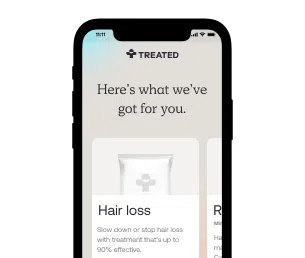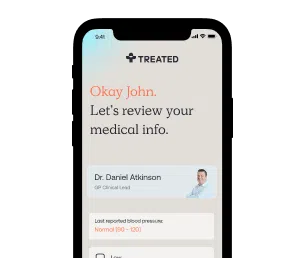Hives
Tablets for a raised, itchy rash.
Secure delivery
UK clinicians
Hives are a condition which causes bumps on the surface of the skin that can be white or red and itchy. The rash is known as urticaria. There are many different causes for hives, including water, friction, temperature and sunlight.
Hives can be both short-lived, and chronic. Order hives treatment online today and take real action.
Hives are a rash caused by an overload of the chemical histamine. They are also clinically known as urticaria. They can be acute and short-term, lasting less than six weeks, or chronic and long-term.
Another type of hives, known as ‘urticaria vasculitis’, causes blood vessels within the skin to inflame. In this case, the rash can last longer than a period of 24 hours and can be extremely painful and cause bruising of the skin.
Hives can be distressing and disrupt daily life and sleep, so it’s important to seek treatment if your symptoms haven’t alleviated within 48 hours.
Just about anyone can get hives, but people with allergies are more likely to develop them, usually when exposed to an allergen. They are also more common in the 20-40 years age group, and hives are twice as common in women.
Acute hives are also more common in adolescents and children, impacting about 3% of children, and in those with atopy.
Hives are quite common, affecting up to 20% of the population over their lifetime. Hives are more common when you’re in your forties, though the peak age for getting them is between 20 to 40 years old.

How we source info.
When we present you with stats, data, opinion or a consensus, we’ll tell you where this came from. And we’ll only present data as clinically reliable if it’s come from a reputable source, such as a state or government-funded health body, a peer-reviewed medical journal, or a recognised analytics or data body. Read more in our editorial policy.
Acute hives usually develop in response to a trigger, like being exposed to something you’re allergic to, or by catching a viral infection like a cold or flu.
We don’t always know why chronic hives happen, but it’s often a combination of several factors. Hives occur when something triggers the body to produce a high level of histamine which is sent to the skin, causing your blood vessels to open up, swell and itch.
Sometimes hives can be caused by an allergic reaction to particular foods, such as milk, eggs or shellfish. Hives can also be brought on by reactions to insect bites, latex, particular drugs like Penicillin and vaccines. They can also appear in response to the skin coming into contact with something, like pressure or an irritant. Common examples include hot or cold water, sitting or lying down for long periods of time and even wearing tight clothes.
The most common symptom of hives is a red and itchy rash. This rash can affect any area of skin on the body. Small areas, which are raised from the surface of the skin (called weals), look like blisters and cause itching. Each weal is usually around 1-2cm across, but can vary from case to case.
Some people may experience a small cluster on one part of the body, but in other cases, weal’s can form over different parts of the body, and can be separate or join up to form bigger ones. They are often round, but can take other shapes as well.
Most people with hives don’t suffer from any other side effects. However, in some cases a condition called ‘angio-oedema’ can appear at the same time as the hives. This condition causes fluid to leak into deeper tissue underneath the skin causing it to swell. This swelling can appear anywhere on the body but is more common on the lips, eyelids and genitals.
If you have hives, you should try not to scratch them. If you break the skin, you risk it becoming infected or scarring. Hives can be distracting or painful but most cases are mild. In severe cases, the tongue and throat can become swollen and can cause difficulty with breathing which would need immediate medical attention.

How we source info.
When we present you with stats, data, opinion or a consensus, we’ll tell you where this came from. And we’ll only present data as clinically reliable if it’s come from a reputable source, such as a state or government-funded health body, a peer-reviewed medical journal, or a recognised analytics or data body. Read more in our editorial policy.
For most people there’s no treatment needed for hives as the rash clears up on its own. However, where treatment is required, antihistamines can provide relief from the symptoms.
Hives are usually treated with antihistamines because the condition is caused by raised histamine levels. This treatment can bring down the rash and ease symptoms.
Antihistamines work by blocking the action of histamine which causes hives. Antihistamines can be taken when a hive rash flares up, this can help the skin to calm quicker than it would do without treatment.
Antihistamines are the first line of treatment. If you have chronic hives and antihistamines aren’t suitable for you, sometimes other medications will be prescribed for short periods, like steroids. This is usually avoided where possible as they can cause unpleasant side effects.
If you have severe hives then you may be referred to a dermatologist or a specialist in allergies.
Hives don’t necessarily need treatment but they can interfere with living a normal life if not treated. There are self-care strategies to help reduce the effects of hives. Some of these include:

How we source info.
When we present you with stats, data, opinion or a consensus, we’ll tell you where this came from. And we’ll only present data as clinically reliable if it’s come from a reputable source, such as a state or government-funded health body, a peer-reviewed medical journal, or a recognised analytics or data body. Read more in our editorial policy.
Have something specific you want to know? Search our info below, or ask our experts a question if you can’t find what you’re looking for.
An approach to the patient with urticaria. Clinical & Experimental Immunology, 153(2), pp.151–161.
Chronic urticaria. Indian Journal of Dermatology, [online] 56(6), p.622.

Fast acting, effective antihistamine tablet that doesn't need a prescription.

One a day tablet that provides fast relief for a range of allergies. No prescription needed.

Generic version of Xyzal. Antihistamine that’s less likely to make you drowsy.

Powerful antihistamine. Prescription strength tablet for effective allergy relief.

One a day antihistamine tablet. Fast relief from a range of allergies.

Non-drowsy antihistamine that gets to work in your body quickly.

Registered with GMC (No. 4624794)
Meet Daniel
Registered with GPhC (No. 2202465)
Meet Sanjeda
Registered with GPhC (No. 2070724)
Meet Craig
Always read the leaflet that comes with your medication and tell us about any side effects you get.
We know health, but you know you.
Our experts tell you what’s safe, but you decide what’s best.
Answer a few questions and tell us about yourself. Get tailored advice from our clinicians so you can choose better.

Choose your treatment and how often you have it delivered.

We know things change. It’s the nature of life. We’ll check in regularly to make sure your treatment is still right for you.
Pause. Change. Skip. Start again. Any time you like.
Here are some other things we can help with.
Choose from our range of tablets and solutions. Get ongoing care and support from our experts.
Stop smoking treatments that can help you kick the habit forever, and reduce your risk of disease.
Tablets or injections. Tailored weight loss treatments combined with ongoing support from our experts.
We're making healthcare more about you. Sign up to our newsletter for personalised health articles that make a difference.
Disclaimer: The information provided on this page is not a substitute for professional medical advice, diagnosis, or treatment. If you have any questions or concerns about your health, please talk to a doctor.
Chronic urticaria. Indian Journal of Dermatology, [online] 56(6), p.622. Available at:
An approach to the patient with urticaria. Clinical & Experimental Immunology, 153(2), pp.151–161. Available at:
We couldn't find what you're looking for.
Here's everything we treat. Or, if you're looking for something we don't have yet, you can suggest something.
If there’s a particular treatment or condition you’re looking for, tell us and we’ll look into it for you.
Submit your question here, or tell us if you’ve found an issue on our site.
We’ll get back to you very soon. We aim to respond to all queries in one working day.
You’re signed up to our newsletter. Keep an eye on your inbox for our latest update.
By clicking 'Subscribe now' you're agreeing to our Privacy Policy.
We’ve sent you an email asking you to confirm your email address.